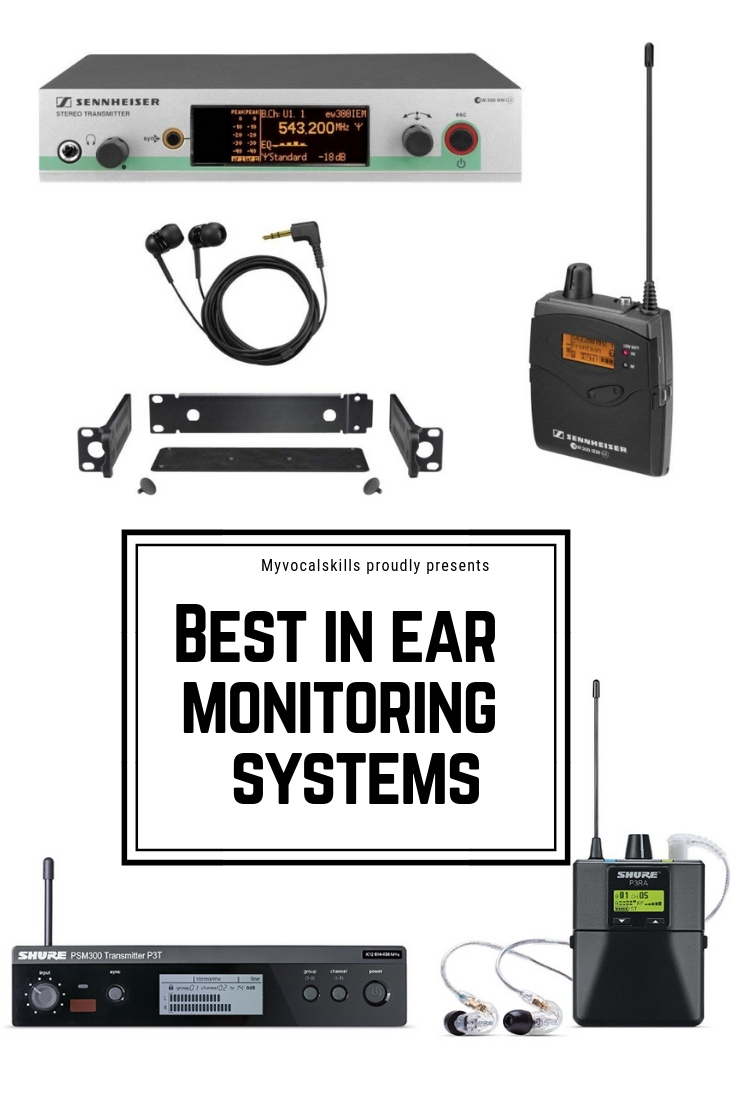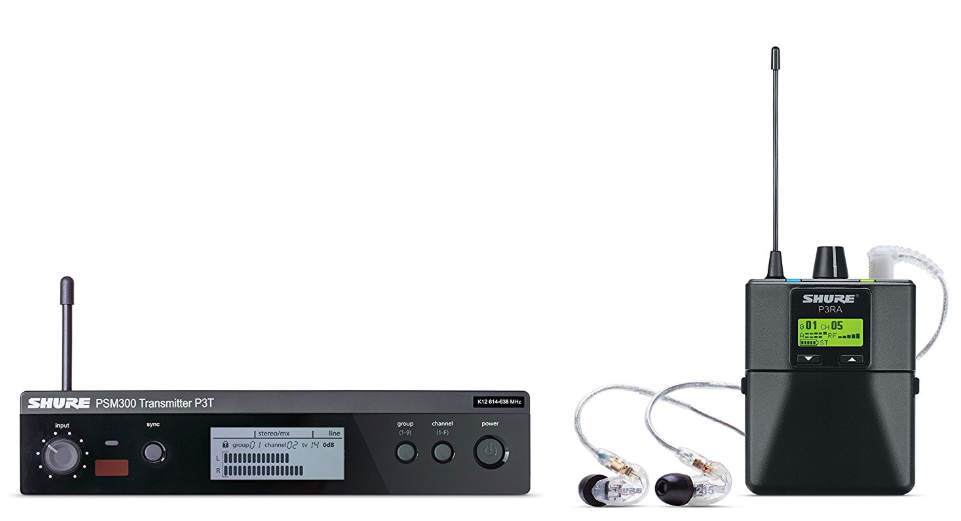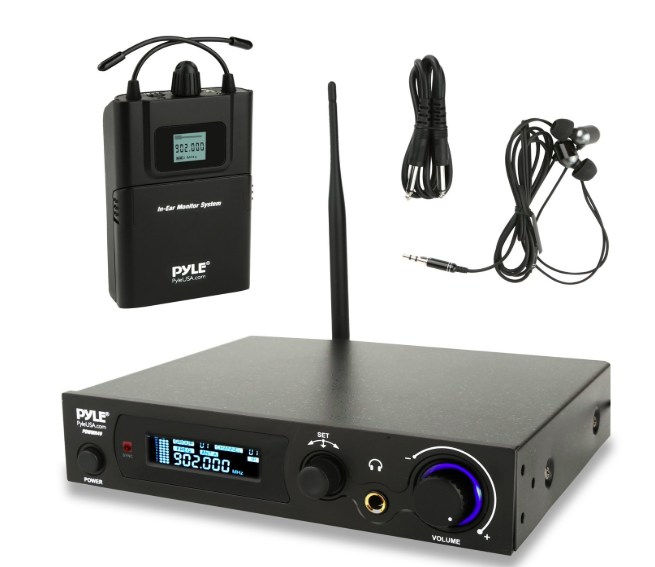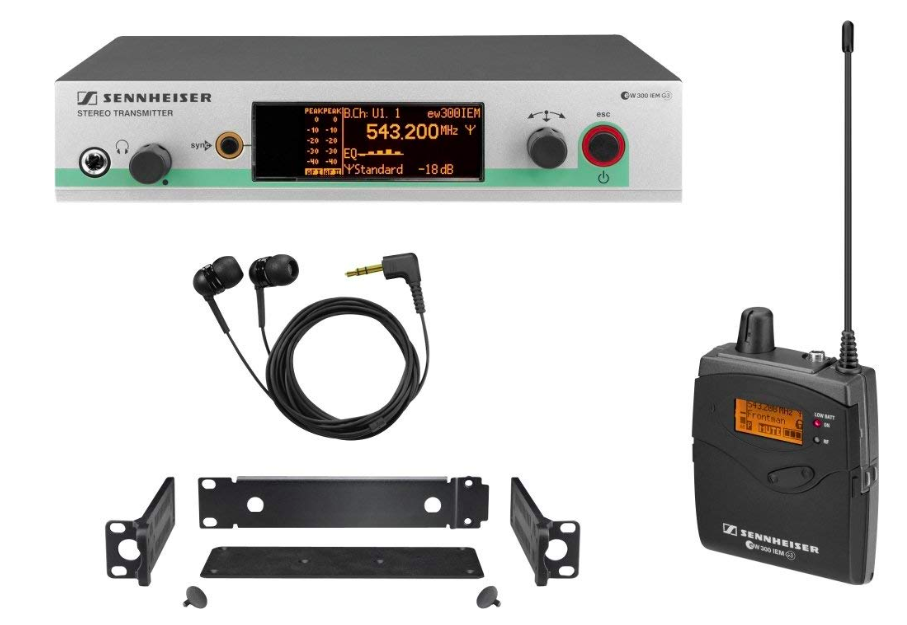Every musician, whether a singer, guitar player or drummer, knows the difficulties that come with playing live. One of the major challenges is, hearing yourself correctly throughout the stage noise.
A possible approach to that common issue is having floor monitors in front of you. However, you’d probably don’t want to remain in the same position through the whole concert. Especially for singers, it’s important to move around and entertain the crowd.

A perfect solution is to use an in ear monitor system. I know, there are some musicians, who hate it, but once I used it, the difference to a stationary monitor was night and day.
In this article I will review the best in ear monitors for musicians, currently on the market. You will find one for every budget and I’m sure, it will lift your live playing to a new level.
Stop relying on the mercy of the sound engineers’ monitor mixes. A personal in ear monitoring can be a real game changer.
Shure P3TRA215CL PSM300 Wireless
Current price: $ 799.00
Where to buy: Amazon
Weight: 7.6 pounds
Dimensions: 18.5 x 14.6 x 4.5 inches
The Shure P3TRA215CL includes P3RA bodypack receiver, P3T transmitter and SE215CL earphones.
P3RA Wireless bodypack receiver
– A rugged and durable aluminum construction
– High-contrast LCD screen, which comes in handy on dark stages
– Auto channel scanning for a quick and easy set-up
– Shape the sound of your monitor mix with mix and volume level controls
P3T Half rack single channel wireless transmitter
– With a coverage, that extends over 300 feet (90 meters) of range
– One-touch IR sync instantly sets up frequencies
– High-contrast LCD menu with detailed L/R audio output meters
– Detachable antenna
SE215CL Sound Isolating Earphones
– Feature Shure’s innovative MicroDriver technology
– Reproduce sound from 22Hz to 17.5kHz
– Include different adapters, for a perfect fit to block out 37dB of outside sound
Minor downfalls
– No XLR input
– Body pack batteries don’t last long.
I recommend getting the SB900 lithium-ionrechargeable batteries
Summary
The Shure P3TRA215CL is a built to last IEM, that ensures the clearest sound, with ultra-low noise and no artifacts. It’s easy to set-up and use. You get professional quality for a great price.
The benefits you’ll get out of using the Shure PSM 300 are obvious:
– LESS STRAIN on your vocals
– IMPROVED STRUMMING and picking
==> Get Your Shure P3TRA215CL PSM300 Right Here <==
Pyle Audio PDWMN49

Current price: $189.99
Where to buy: Amazon
Weight: 3.65 pounds
Dimensions: 16.2 x 3 x 12.2 inches
Starting at the lower entry level, the Pyle Audio PDWMN49 are an affordable IEM, that just gets its job done.
Compact and Wireless
– The Pyle wireless in ear monitor and receiver system offers tabletop stage monitoring with a wireless range of up to 330 feet.
– Can be use it in the studio as well as on stage.
– The kit includes an audio system transmitter, a digital belt-pack receiver, and in-ear headphones.
Pros
– Simple controls for hassle-free operation
– Selectable audio frequency to optimize your sound
– 100 different channels
– Frequency range of 902-928 MHz, this professional quality item system operates perfectly in both a studio and stage environment
– Reliably consistent signal quality wherever you move
– Batteries seem to last about 8-10 hours
– Attractive price, which is just a fraction compared to other systems
Cons
– It’s not built like a tank
– Stock earphones are pretty crappy, just change them with any other earphones asap
– The receiver is of cheap material
Though, the Pyle is no high-end, fancy IEM, it is a good choice, if you are low on budget. It’s functional and does, what it has to do. Make you hear better when you’re on stage.
==> Get Your Pyle Audio PDWMN49 Right Here <==
Sennheiser EW 300 IEM G3
Current price: $999.95
Where to buy: Amazon
Weight: 22.7 pounds
Dimensions: 17.8 x 2.9 x 14.7 inches
The Sennheiser EW 300 IEM G3 is simply the best wireless system you could get for this price. German designed and American built it offers even more features, that you will ever get to use.
Features
– 1680 tunable UHF frequencies for interference-free reception
– Auto scan
– Pilot tone squelch feature for eliminating interference when transmitter is turned off
– Enhanced frequency bank system with up to 16 compatible frequencies
– Automatic frequency scan feature searches for available frequencies
– Ethernet port for connecting to the Wireless Systems Manager (WSM) software for control via computer: delivers a good overview of monitoring and professional data management for multi-channel systems
– Integrated 5-band graphic Equalizerin transmitter for adjusting sound
– HiBoost, adjustable limiter to avoid peaks in volume
– Stereo/focus mode, balance in receiver
Pros
– Easy to set up system
– Great stereo image and separation
– Gain availability in is more than anyone would need,
– Superior options of digitally adjustable levels, HF emphasis, EQ availability
– Fine sound and the options available with this transmitter/receiver pair are obviously superior. I am thinking here, and very fine sound quality.
– This awesome, high quality IEM comes for a respectable price
Room for improvement
– The earbuds are decent, although customs will make this system shine
There’s no doubt: If you want the best in this price class, you should look no further.
==> Get Your Own Sennheiser EW 300 IEM G3 Right Here <==
Conclusion
If you are any serious about your live vocal performance, you can’t get around of owning an in ear monitor system. Once you get one of these babies, you will never go back.
There are currently some excellent products on the market. If you just start out with little money Pyle Audio PDWMN49 will be your first choice. More advanced performers will be more than happy to work with the incredible Shure P3TRA215CL PSM300 Wireless. If you want the best deal under $ 1.000, you should set out for the amazing Sennheiser EW 300 IEM G3.
Hope you have a clearer picture now, which IEM works best for you.
Let me hear what you think. What are your own experiences with in ear monitors? Did I leave out your favorites?
Rock the stage
Felix

wow technology is amazing. I did think that a device like this was available on the market for singers to use. It dies seem a little pricey, even from amazon. Do you know if there are comparable brands for a better price, or is this your number 1 recommendation? Thanks, Kenny
You’re right, compared to stage microphones, in ear monitoring systems are more pricey. I wouldn’t suggest going for something cheaper than the Pyle. That’s why I suggested it for absolutely entry level IEM.
Wow, some of these systems are really expensive! I often thought of what musicians do for their ears while playing loud music. I think I would choose the Pyle on Amazon and mostly because of the cost.
But will it do the job it’s intended to do or must you really have to spend that much more for a better system? I have to say that these systems are worth whatever you have to pay for because it’s an important part of the performing music and protection for your ears.I’ve never used one so I’d be interested to know which is the best of them all and why.
Thanks for your comment Rob. I mentioned the Pyle in my review, because it basically works and comes for a good price. Nevertheless, the more professional you get and the more gigs you play and have to rely on a good IEM, the better off you are climbing up the quality ladder.
Hi Felix!
I’ve never been a soloist, but I have performed in vocal groups and played my viola before an audience. I completely understand how the noise can drown out your voice and if you’re not careful, you could be completely off pitch. I haven’t noticed anyone using ear monitors in performances. How do they camoflage them? Are the small and easily hidden? Would they work to give a similar clarity to groups who perform. This is a great idea to have for performances. I’d love to hear more of your thoughts on this.
Hi Tiffany. Actually, there’s no need for camouflaging. Naturally, in ear monitoring system are small, but will always be visible. Most professional musicians use them (not only singers) and if you look closely, you will always detect them. There will always be some kind of a monitoring system on stage for everyone in the group, because you need to hear yourself accurately. Imagine a drummer, who don’t hear the guitar or bass, will be lost. This goes for all band members.
Hey Felix, nice article. I’ve never been a musician but I can say that I love the passion that you showed in the article and your choice of ear monitors are ideal for people who are looking for certain tools to help their musician career. I’ve wanted to play an instrument but never got into it but your article rocked and a great read. Good job!
Thank you for your nice comment!
Great recommendations but I must admit I don’t really know what an ear monitor does for you. How does it help you regulate and adjust your vocals during real time, live performance?
I am am relatively amateur musician so I don’t know a whole lot about these types of things. I have performed live a couple of times but not much more than that.
Hi Mariah, thanks for reading and commenting. You can make your own live mix with your in ear monitoring. If you find, you need to hear your own voice (or instrument) better, you adjust. If you need guitar louder for staying on pitch, you can do that as well.
For a better singer, the ultimate stage performance goal is to be loud and audible and also be able to clearly and distinctively hear every bit of your vocal input. Amidst the incessant noise, it is practically impossible to achieve without an in-ear monitor. I love the Sennheiser EW 300 IEM G3 due to its auto scan, Ethernet connectivity and it’s enhanced frequency bank. I always recommend this though it’s kind of expensive but that’s the best you can ever wish for.
I believe the time is coming when you are gonna be in control of your vocals on stage with just the press of a button from your watch.
Make the music worth it. Sing on, amplify your voice and make the much needed impact.
Thanks for this comment. As you said and also reflected in my review. The Sennheiser is the best in class here.